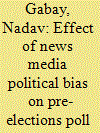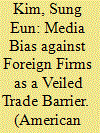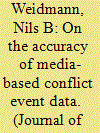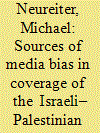|
|
|
Sort Order |
|
|
|
Items / Page
|
|
|
|
|
|
|
| Srl | Item |
| 1 |
ID:
187566


|
|
|
|
|
| Summary/Abstract |
Research has had very little to say about whether polling predictions of elections outcomes are biased in line with the political bias of the news outlets that commission the polls. This article examines the relationship between news media political bias and bias in the published results of media-sponsored pre-elections polls in the three Israeli elections that took place in 2019–20. Given that these elections were largely referenda on Benjamin Netanyahu’s corruption charges – dividing the political system, the media, and the Israeli public into pro-Netanyahu and anti-Netanyahu camps – media political biases are narrowly defined in accordance with news outlets’ general attitudes to the charges. Thus, polling bias is defined as a systematic overestimate or underestimate of the number of parliamentary seats that the bloc of pro-Netanyahu parties will actually receive. It is found that, on average, polls commissioned by anti-Netanyahu media consistently underestimated the number of seats that the pro-Netanyahu bloc would win.
|
|
|
|
|
|
|
|
|
|
|
|
|
|
|
|
| 2 |
ID:
162767


|
|
|
|
|
| Summary/Abstract |
Machine-coded event datasets have become popular in conflict research. I argue that systematic media biases render news-based event data unsuitable for studying networks of insurgents and political parties. Insurgent networks are too secretive to be captured by media reports, whereas alliances among regular political parties are too constant to be considered newsworthy. I analyze the data accuracy of the network study of insurgents and political parties in Thailand by Metternich et al. (2013), which is based on the most comprehensive event dataset currently available: Lockheed Martin's International Crisis Early Warning System (ICEWS) project. Using simple evaluation criteria, I show that most of the network data entries are incorrect, leading to a depiction of the networks that is unrelated to real-world cleavages in Thailand. While my hand-coded event dataset captures relatively more network-relevant information than ICEWS, the comparison confirms that journalists specifically underreport cooperative events among insurgents and parties. In addition, the ICEWS project provides unreliable counts of conflictual events in Thailand. Using alternative conflict measurements from the Deep South Watch dataset and a dummy variable based on established periods of unrest, I show that violent activities in Thailand's Deep South declined during periods of conflict between pro- and anti-Thaksin groups. Conflicts were unrelated to network fragmentation, contradicting the primary finding of Metternich et al.
|
|
|
|
|
|
|
|
|
|
|
|
|
|
|
|
| 3 |
ID:
147425


|
|
|
|
|
| Summary/Abstract |
Major advances in research on media bias have been achieved in recent years. However, methods used in the literature are primarily applied to American media and usually dependent on the two-party system. This paper attempts to detect and quantify the principal difference, or ‘media bias’, of Chinese media. We extract a document-term matrix from articles on the Eighteenth Party Congress in November 2012 from 21 Chinese newspapers from seven provinces, as well as the People's Daily. With this matrix, hierarchical clustering is subsequently used to divide newspapers into two groups. Using the dendrogram and intergroup dissimilarities, we can construct an index to indicate the direction and the magnitude of media bias. In our sample, newspapers from Zhejiang and Guangdong constitute one group, and the rest constitute the other group. The principal difference of Chinese media is reflected in two dimensions: central/local and political/economic.
|
|
|
|
|
|
|
|
|
|
|
|
|
|
|
|
| 4 |
ID:
162221


|
|
|
|
|
| Summary/Abstract |
While the rules of international trade regimes prevent governments from employing protectionist instruments, governments continue to seek out veiled means of supporting their national industries. This article argues that the news media can serve as one channel for governments to favor domestic industries. Focusing on media coverage of auto recalls in China, I reveal a systematic bias against foreign automakers in those newspapers under strict government control. I further analyze subnational reporting patterns, exploiting variation in the level of regional government interest in the automobile industry. The analysis suggests that the media’s home bias is driven by the government’s protectionist interests but rules out the alternative hypothesis that home bias simply reflects the nationalist sentiment of readers. I show that this home bias in news coverage has meaningful impact on actual consumer behavior, combining automobile sales data and information on recall-related web searches.
|
|
|
|
|
|
|
|
|
|
|
|
|
|
|
|
| 5 |
ID:
141193


|
|
|
|
|
| Summary/Abstract |
Empirical researchers of civil war rarely collect data on violence themselves and instead rely on other sources of information. One frequently used source is media reports, which serve as the basis for many ongoing data projects in the discipline. However, news reports rarely cover a conflict comprehensively and objectively and may therefore be prone to various reporting issues. This article provides an analysis of the accuracy of information given in news reports. In particular, if focuses on two types of “hard facts” that event data sets require: the location of an event and its severity. By linking media reports to firsthand accounts from a military database, the article does two things: (1) it analyzes the determinants of inaccuracy and confirms the expectation that events with a low number of observers tend to have higher reporting inaccuracies and (2) it assesses the magnitude of these inaccuracies and the implications for conducting empirical analyses with media-based event data.
|
|
|
|
|
|
|
|
|
|
|
|
|
|
|
|
| 6 |
ID:
151685


|
|
|
|
|
| Summary/Abstract |
This article examines the sources of media bias in coverage of the Israeli–Palestinian conflict by applying Dave D’Alessio and Mike Allen’s framework for measuring media bias to a sample of German, British, and US newspaper articles on the 2010 Gaza flotilla raid. It suggests that British and especially German newspapers exhibit a significant anti-Israel bias, whereas the results for the United States are mixed. Testing five potential explanations for the occurrence of media bias in the context of the Israeli–Palestinian conflict, this article also suggests that a newspaper’s ideological leaning as well as a country’s public opinion, demographic make-up, and relationship with Israel explain the occurrence of these biases rather well, whereas national business interests do not.
|
|
|
|
|
|
|
|
|
|
|
|
|
|
|
|
|
|
|
|
|